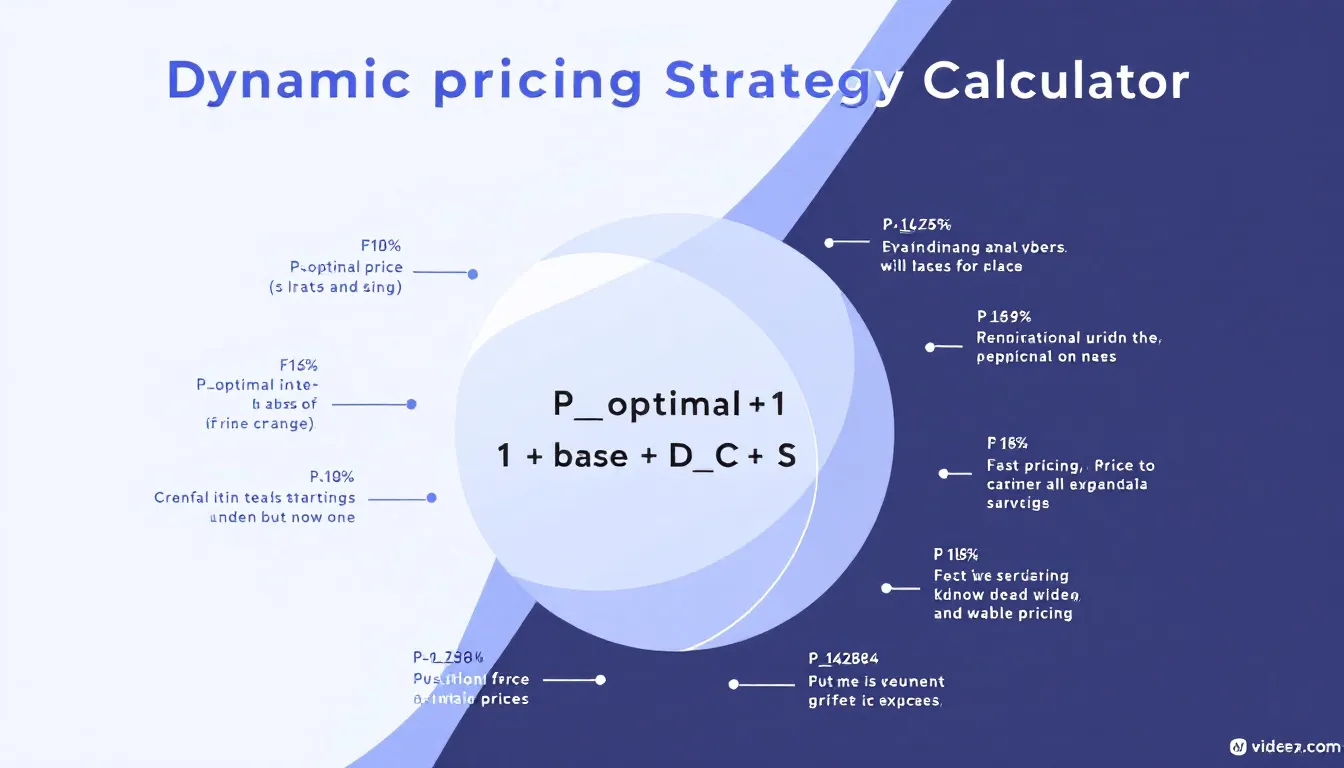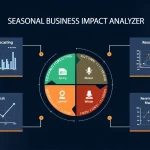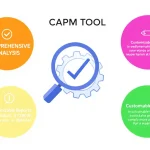Is this tool helpful?
How to Use the Dynamic Pricing Strategy Calculator Effectively
1. Product or Service Name
Enter the name of the product or service you want to analyze for dynamic pricing. This helps the tool tailor the pricing recommendations to your specific offering. Examples you can use include:
- Organic skincare products with varying demand during holidays
- Online course subscriptions with promotional periods
2. Current Base Price
Input your existing standard price for the product or service. Try to be as accurate as possible for meaningful price optimization results. Sample inputs could be:
- $49.99 for monthly software licenses
- $120 per night for boutique bed and breakfast rooms
3. Market Conditions
Select the current market condition from options like growing, stable, declining, or seasonal fluctuations. This reflects real-world influences on your pricing, such as:
- Increased demand during a new product launch
- Seasonal demand drops during off-peak months
4. Competitor Pricing Range
Enter the minimum and maximum price points set by your competitors. This range gives insight into competitive pressure on your pricing. For example:
- $25 – $45 for popular fitness trackers
- $80 – $150 per service package at local marketing agencies
5. Current Demand Level
Choose the present demand level such as high, medium, or low to help the calculator adjust prices according to customer interest and sales momentum. For instance:
- High demand: Trending tech gadgets before holiday season
- Low demand: Slow-moving inventory during a market downturn
What the Dynamic Pricing Strategy Calculator Does and Why It Matters
The Dynamic Pricing Strategy Calculator helps you optimize your pricing to respond to market changes quickly and strategically. Using your inputs, it analyzes multiple factors—market trends, competitor prices, demand levels—to suggest pricing adjustments that maximize revenue without losing competitiveness.
By tailoring prices dynamically, your business gains flexibility to capture higher margins during peak demand and stay attractive when the market cools. This tool supports smarter decisions, better inventory management, and faster adaptation to market shifts.
Key Benefits of Using This Tool
- Boost revenue by adjusting prices based on real-time data
- Stay competitive by tracking and responding to competitor pricing
- Improve resource utilization and reduce losses from underpricing
- Support data-driven pricing decisions across different market scenarios
Practical Applications and Example Strategies
Example 1: Subscription Service
An online streaming platform uses the calculator with these inputs:
- Base price: $12.99/month
- Market condition: Growing market with rising demand for original content
- Competitor pricing: $9.99 – $15.99 per month
- Demand level: High during new show releases
The generated strategy might recommend a slight premium during peak months with exclusive content, balanced by promotional discounts during slower periods.
Example 2: Restaurant Industry
A local restaurant analyzing its pricing might enter:
- Base price: $25 per dinner plate
- Market condition: Seasonal fluctuations with summer tourism boosts
- Competitor range: $20 – $35 for similar menus
- Demand level: Medium, higher on weekends
The tool could suggest raising prices on weekends and during festivals, with off-peak discounts to attract local customers.
Understanding the Dynamic Pricing Formula
The pricing optimization model behind this tool calculates an optimal price ($$P_{optimal}$$) based on several weighted factors:
Where:
- $$P_{optimal}$$: Optimized target price
- $$P_{base}$$: Your current base price
- $$\alpha$$: Demand sensitivity coefficient reflecting how price reacts to demand changes
- $$D$$: Demand level (e.g. high, medium, low)
- $$\beta$$: Competition coefficient indicating effect of competitor prices
- $$C$$: Competitive pressure based on competitor pricing range
- $$\gamma$$: Seasonality coefficient for seasonal impacts
- $$S$$: Seasonal factor such as peak or off-peak periods
Strategic Tips for Implementing Dynamic Pricing Successfully
1. Collect Accurate and Relevant Data
- Track your sales history and patterns closely
- Monitor competitor pricing regularly
- Understand seasonal trends and customer behavior
2. Set Clear Pricing Rules and Boundaries
- Define minimum and maximum acceptable price limits
- Establish triggers for price adjustments, like demand spikes or promotions
- Create customer segment-specific rules when needed
3. Continuously Monitor and Adjust
- Use automated systems to apply pricing changes instantly
- Analyze performance metrics to measure pricing success
- Update your pricing strategy as market conditions evolve
Frequently Asked Questions About Dynamic Pricing
How often should I update my dynamic pricing strategy?
Update your strategy based on market activity. Fast-moving markets call for daily or weekly reviews, while stable industries may only need monthly or quarterly updates.
Is dynamic pricing suitable for all business types?
Dynamic pricing works best for businesses facing fluctuating demand or limited inventory, such as hospitality, retail, and services. However, most businesses can apply some form of dynamic pricing to improve profitability.
How do I determine the best price range using this tool?
Consider your costs, competitors’ prices, and how much customers are willing to pay. This calculator helps synthesize those factors to recommend an optimal price range for your product or service.
Which market factors should I prioritize?
Focus on demand variations, competitive pricing pressure, seasonal trends, and customer segment behaviors. These significantly influence your ability to set effective dynamic prices.
How can I measure if my dynamic pricing strategy is working?
Track metrics like revenue growth, profit margins, market share, customer satisfaction, and how quickly inventory moves. These indicators reveal if your pricing adjustments are meeting business goals.
Best Practices for Maximizing Dynamic Pricing Impact
1. Communicate Clearly with Customers
- Be transparent about how prices may change
- Explain the value behind pricing variations
- Provide clear and consistent pricing information
2. Monitor Competitors Consistently
- Conduct regular market research
- Track competitor pricing updates
- Analyze industry trends to stay informed
3. Invest in Robust Technical Systems
- Implement automated pricing tools for real-time adjustments
- Set up comprehensive data analysis and reporting dashboards
- Continuously refine strategies based on performance data
Important Disclaimer
The calculations, results, and content provided by our tools are not guaranteed to be accurate, complete, or reliable. Users are responsible for verifying and interpreting the results. Our content and tools may contain errors, biases, or inconsistencies. Do not enter personal data, sensitive information, or personally identifiable information in our web forms or tools. Such data entry violates our terms of service and may result in unauthorized disclosure to third parties. We reserve the right to save inputs and outputs from our tools for the purposes of error debugging, bias identification, and performance improvement. External companies providing AI models used in our tools may also save and process data in accordance with their own policies. By using our tools, you consent to this data collection and processing. We reserve the right to limit the usage of our tools based on current usability factors.







